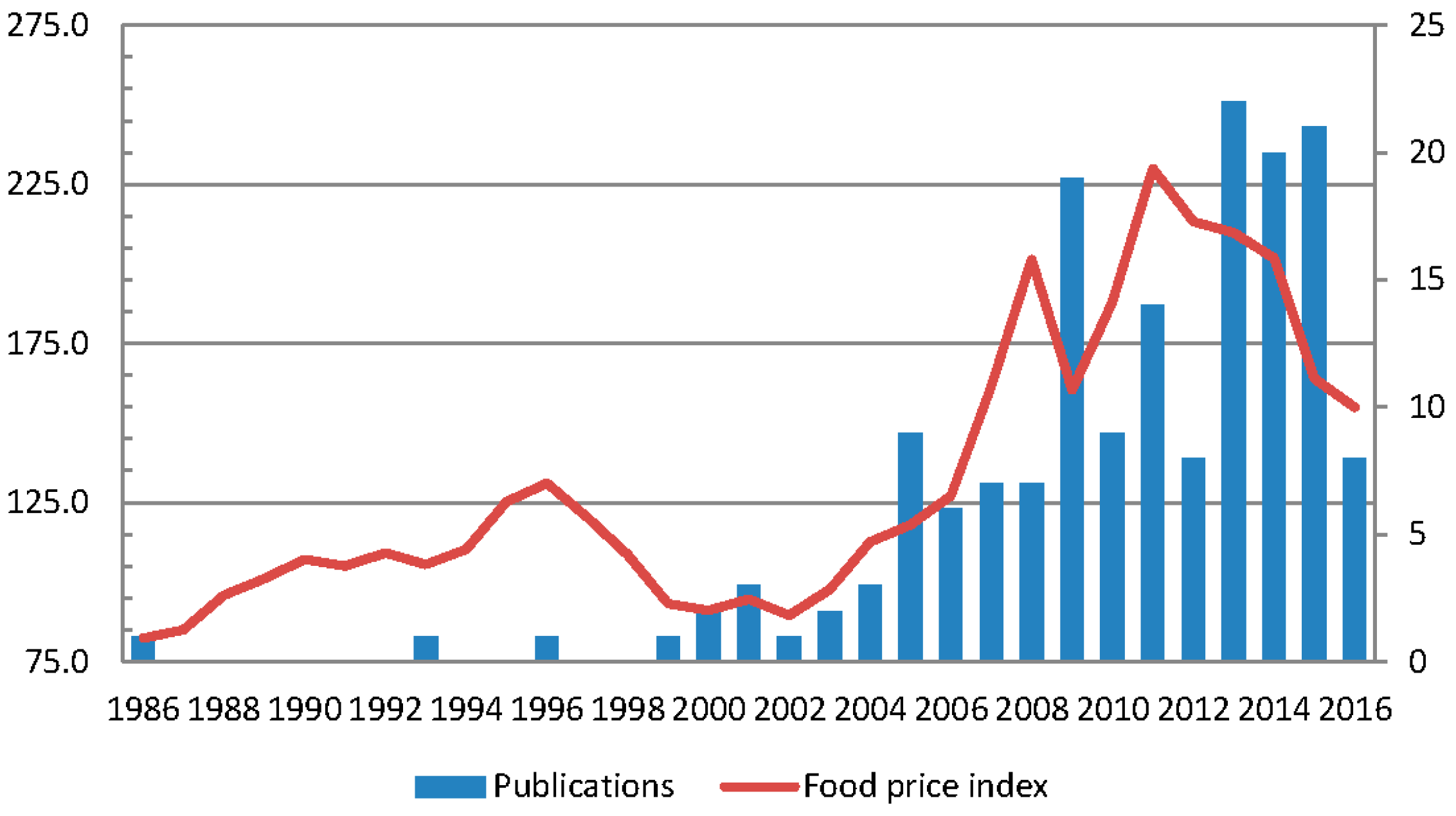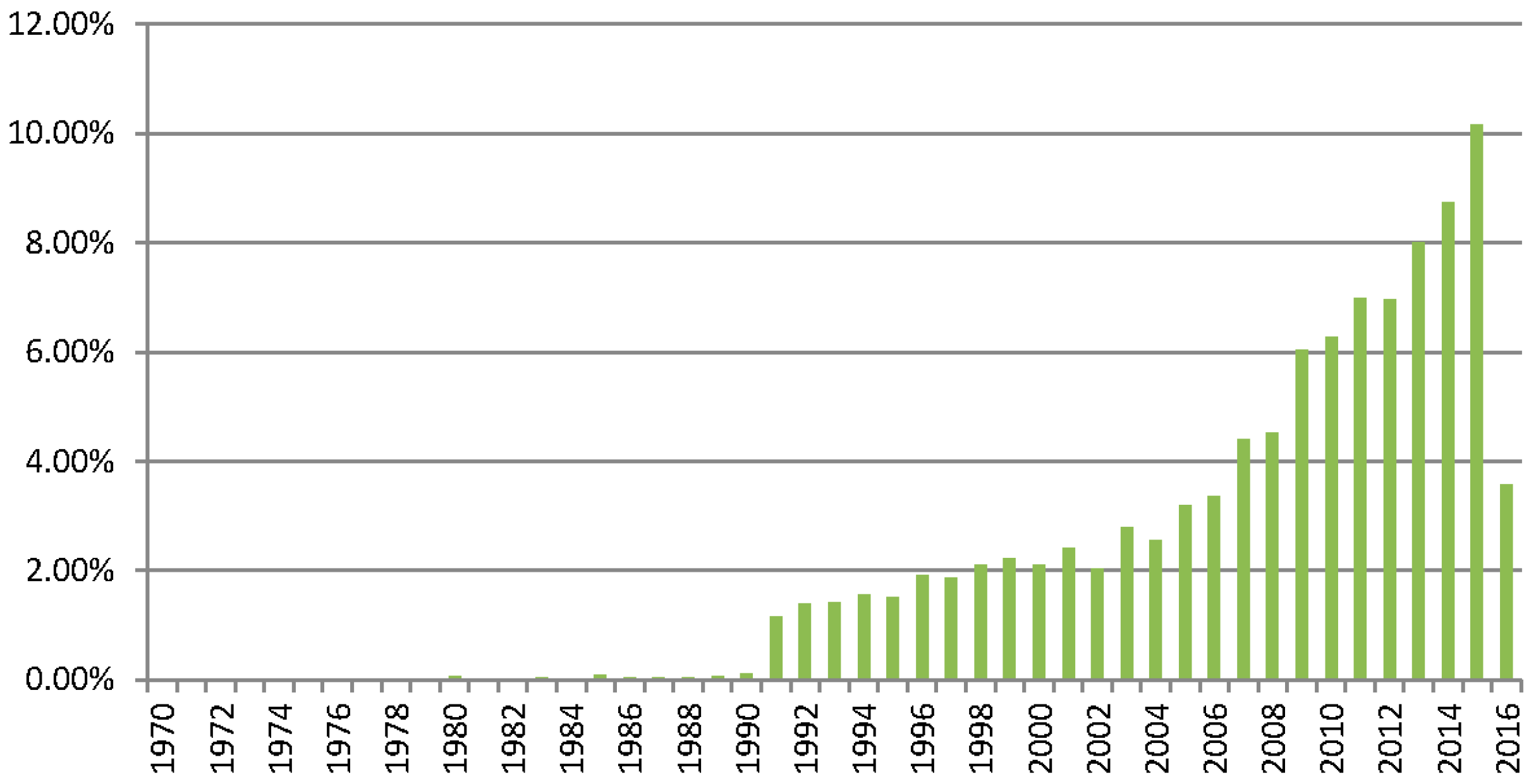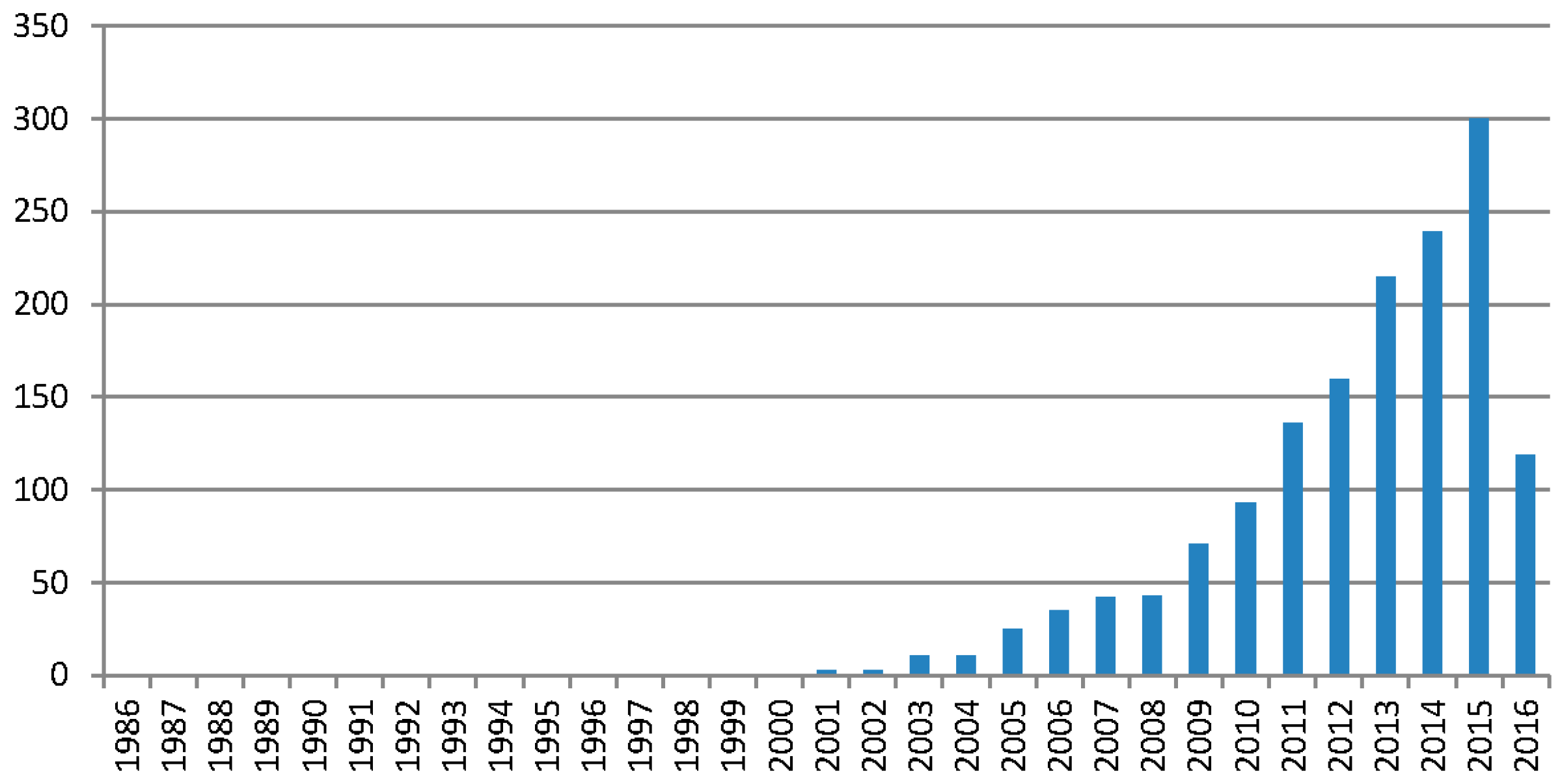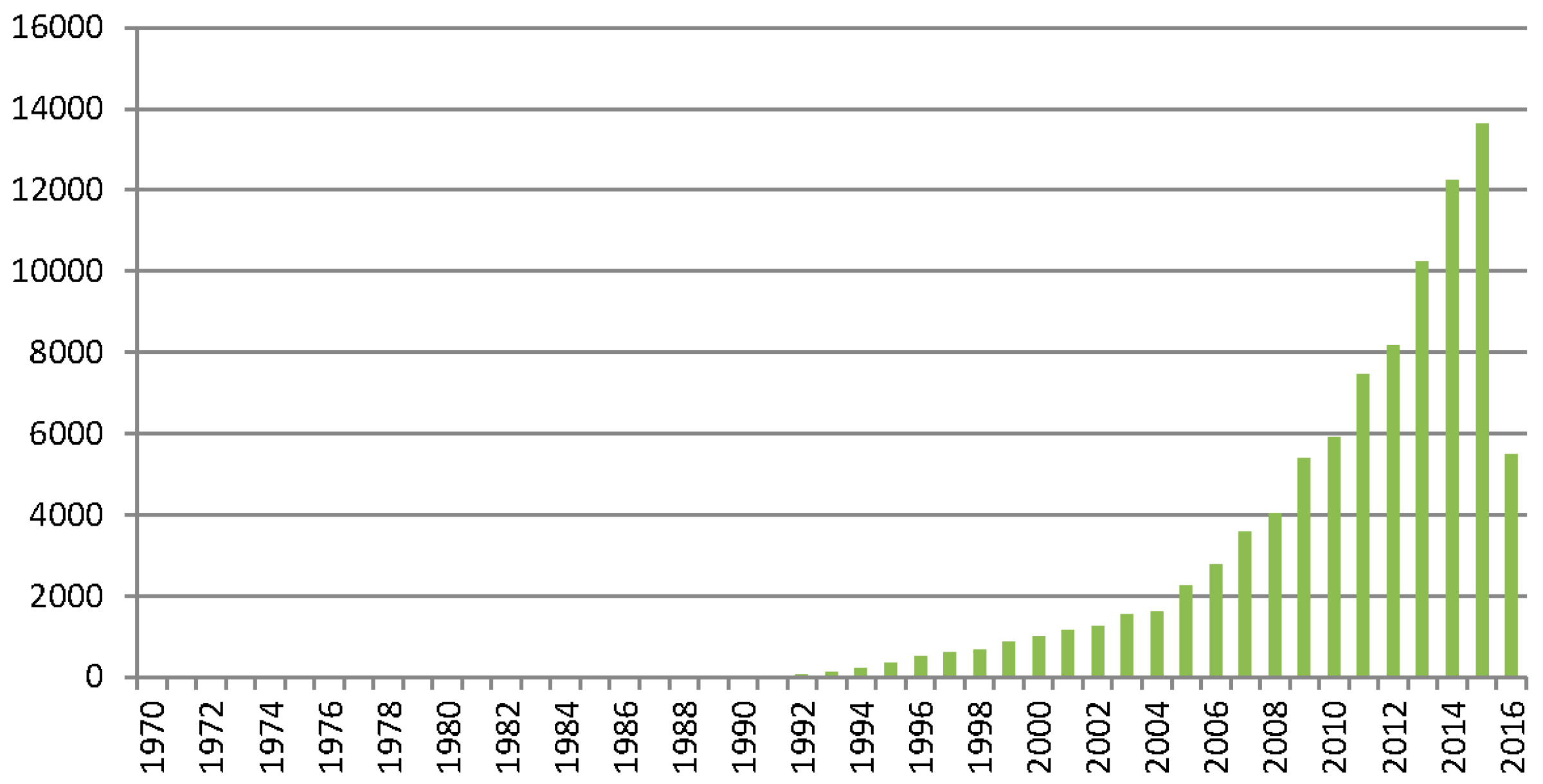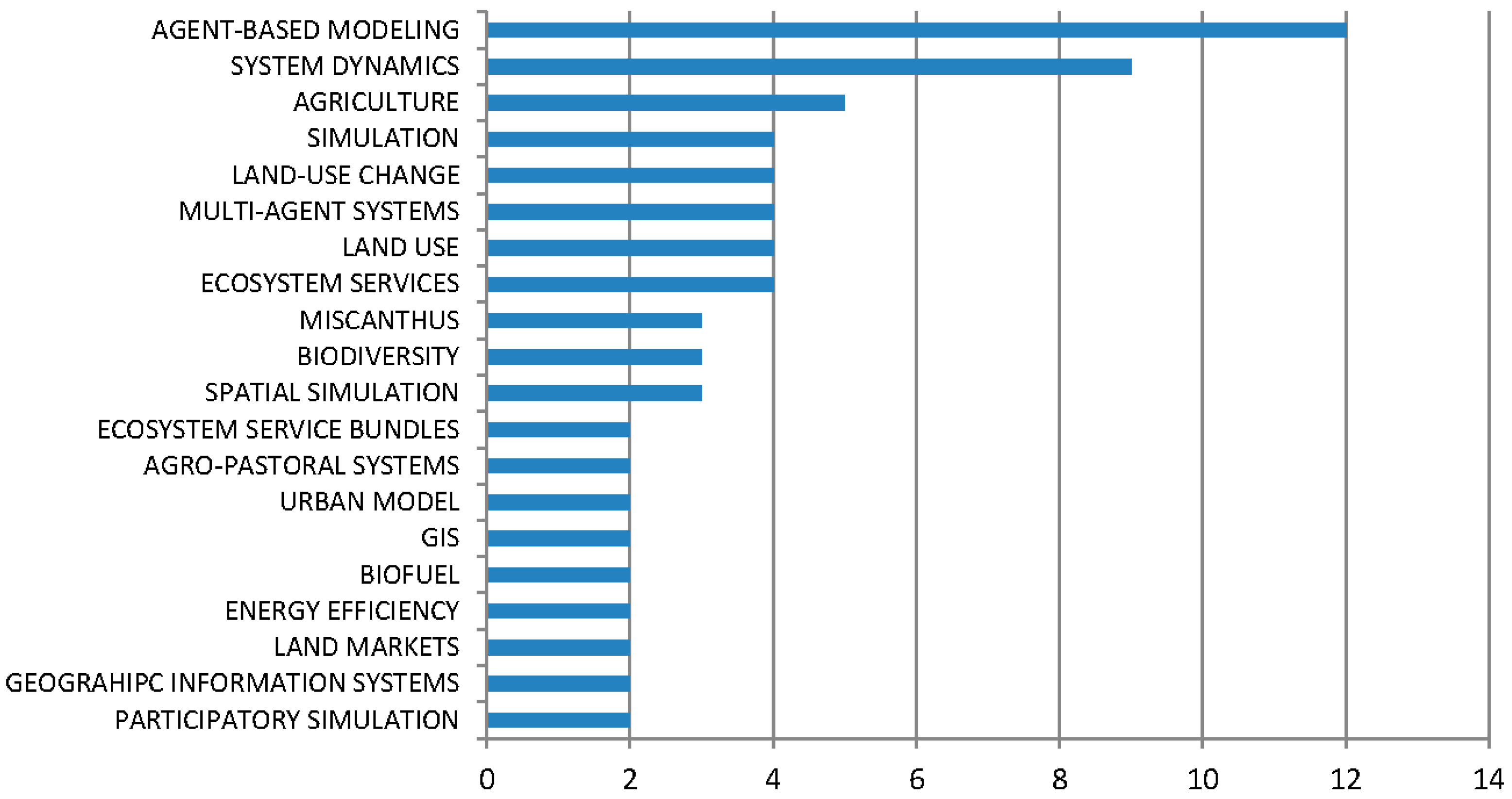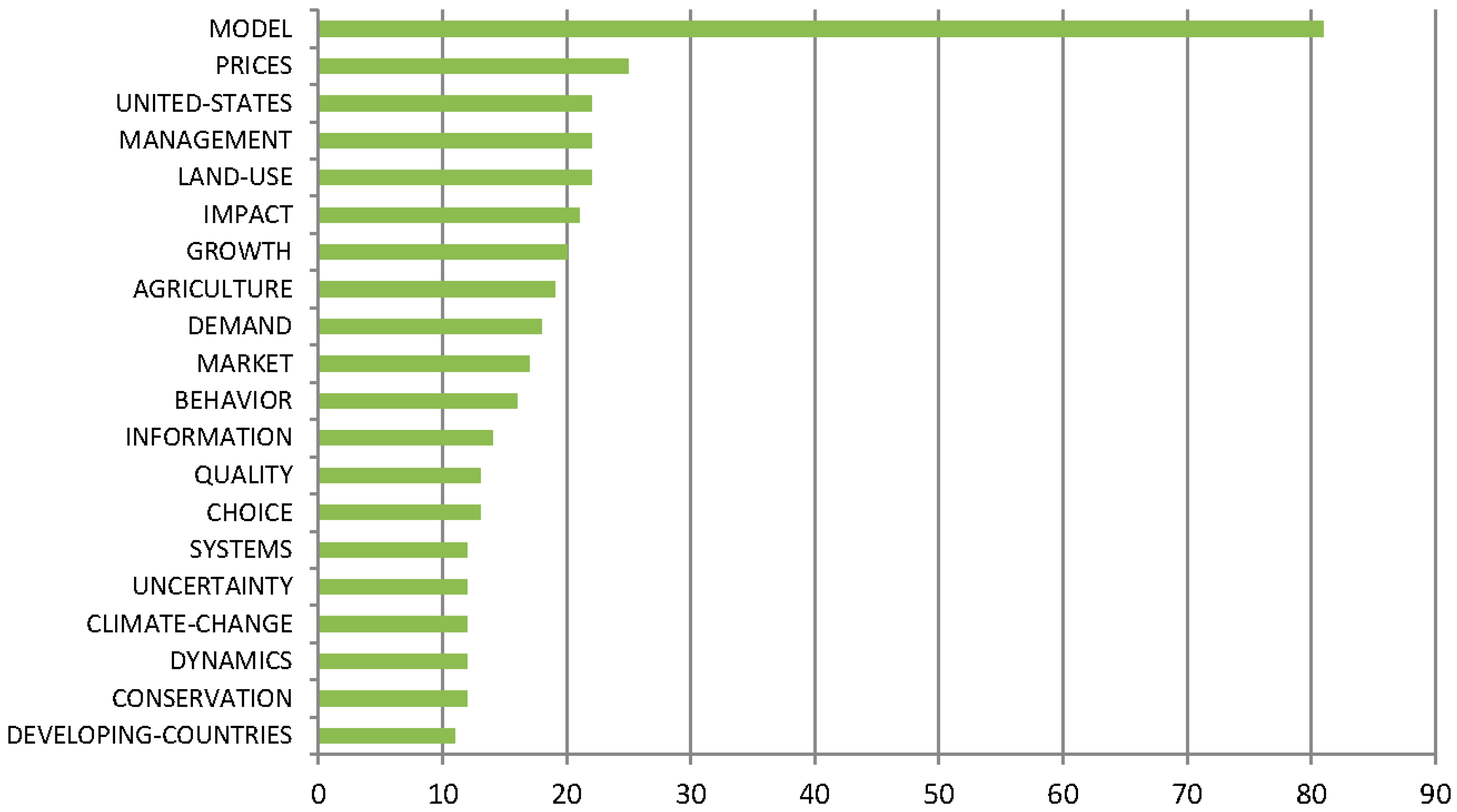1. Introduction
Latest scientific analyses suggests that the impact of climate change on world food production in the next decade is going to be mostly negative [
1,
2,
3,
4], putting food systems under stress, and exacerbating the existing challenge to guarantee food security to a growing global population [
5,
6]. Agriculture is a fundamental part of the food system, which involves numerous actors along the food value chain (growing, processing, trading, and selling) from farm gates to fork. Food production is deeply interconnected with weather and climate. Indeed, agriculture contributes to roughly 30% of Green House Gases (GHG) emissions—the production of crops and animal products releases roughly 13% and the rest due to land use change and deforestation [
7]. At the same time, it is negatively impacted by climate change. More frequent and extreme weather events affect food production and price volatility, and accelerate land erosion damaging ecosystems and leading to crop failures. These issues have implications for local and global development in a growing and warming planet [
8]. The United Nations Department of Economic and Social Affairs (UN DESA) estimates [
9] show increasing population (expected to rise to 9.6 billion in 2050 driven by higher fertility, rapid increase in life expectancy at birth in Sub-Saharan Africa and India) and urbanization (almost 70 percent by 2050). In addition to social changes (1.2 billion people joining the middle class in emerging economies), they are able to exacerbate environmental pressure without a change in global policy towards resilience. Thus, meeting the sustainable development challenge of the Post-2015 Agenda means assuring timely access to key resources, such as food, in a more unstable world. The last food commodity crisis which started in 2007 showed that food is deeply linked to other important but constrained resources such as water and energy. In fact, challenges to what we can define the food-water-energy nexus are interdependent: a shock on a single resource may have a cascading effect on the others, and define overall negative impacts on the human/environmental system.
An answer to the complex relation between agriculture, climate change and sustainable and inclusive development was recently provided by Climate Smart Agriculture (CSA) [
10,
11] that relies on sustainable agricultural intensification and resource resilience, by adopting mitigation and adaptation measures to curb GHG emissions linked to agriculture, waste and pollution. But a robust quantitative framework of analysis for modelling CSA has not been identified nor developed yet. Traditional tools of analysis rooted in neoclassical economic theories were not built to address the complexity, multidimensionality and non-linearity of the relations that characterise CSA approach.
Useful alternatives to study the complexity of the food system are represented by System Dynamics (SD) and Agent Based models (ABM), which are simulation models that mimic the dynamic behaviour of the system they try to reproduce in its functional relationships. Despite their potentialities, SD and ABM have only been recently applied to agri-food systems and sustainability analysis, and a comprehensive bibliometric analysis on their publications’ performance and characteristics is missing. In this paper we are going to fill in this gap by analysing publications in scientific journal and keywords in what we define as the traditional agricultural modelling community (AM), which relies on the use of neoclassical models, and in the agricultural complex systems modelling community (ACSM), which relies on the use of SD and ABM. For our analysis we rely on the ISIWeb of Science dataset provided by Thomson Reuters [
12] that is considered to be one of the best depositories of journals in the field.
The paper is structured as follows.
Section 2 briefly highlights strengths and weaknesses of AM and ACSM.
Section 3 describes the methodology used for the bibliometric analysis.
Section 4 presents and discusses the main results in the AM and ACSM areas.
Section 5 concludes.
2. Modelling Agri-Food Systems in a Comparative Perspective
Through the years, in order to provide a more comprehensive representation of the agri-food system, new models rooted in neoclassical theory assumptions were developed. Alongside with the number of models, the complexity of the methodological framework proposed increased. This is the case of Computable general equilibrium models (CGE) and partial equilibrium models (PEM) that are built around the neoclassical concept of equilibrium, i.e., an economy is supposed to grow at its potential path unless it is disturbed, assuming linear growth and exogenously-driven changes in average behaviour. They use equations that specify supply and demand behaviours to simulate different markets, and the markets are brought to equilibrium by solving the model usually for a set of prices. Two main examples are the Common Agricultural Policy Regionalized Impact (CAPRI) model, a CGE developed by a network of European research teams with the support of the European Commission [
13], and the PEM FAPRI developed at Iowa State University and the University of Missouri (USA), and applied to the UK by Agri-Food and Biosciences Institute and Queen’s University Belfast [
14]. The models aim at analysing and evaluating alternative agricultural policy scenarios. They have some desirable characteristics. In particular, they can:
- -
Simplify the understanding of how our economies work/may work under ideal conditions;
- -
Model the elasticity of sectors and aggregates’ response to a change in the explicative variables;
- -
Isolate the role of a model variable on the outcome, controlling for the influence of other determinants;
- -
Estimate the magnitude of the error term, i.e., what cannot be explained by the model in the relation; Provide policy scenarios in the medium to long term, given the model assumptions.
Yet, these modelling approaches were not developed to represent the dynamics of a complex system characterized by non-linearity, causal feedbacks, time delays, non-rationale elements and policy path dependency which characterize sustainable development. Sector specific models or agricultural productivity models have a number of known limitations for estimating a range of agricultural policy impacts. These include substantial model-to-model variability, difficulty in estimating growth parameters, and difficulty in representing the range of behavioural responses of farmers to different kinds of climatic and/or economic stresses. They often lack process-level detail on crop growth functions, but have more ability to represent land use allocation and the interaction of the agricultural sector with the evolution of the energy sector in partial equilibrium models, and with other sectors of the economy in computable general equilibrium models. In particular, they do not allow us to understand whether time lags between the imposition of a stress and how farmers (and markets) respond, constitute a major source of uncertainty. Simple considerations of dynamics suggest that time lags in complex dynamical systems have the potential to be destabilizing. But we have little idea of how this concept might be applied to agricultural and linked economic systems. A key issue is that in many CGE and PEM models, prices and agents respond immediately after a shock occurs (e.g., farmers adapting their investing or land allocation choices), without accounting for time lags in prices perceptions (information delays) and land conversion in the case of farmers’ behaviour (material delay). Then, the long-term focus of many CGE and PEM models makes them less well-suited to some aspects of climate stresses, which may manifest themselves as a sequence of seasonal and annual events and to meet short term policy demands. For instance, climate impacts on agriculture will often be expressed as the consequence of a sequence of events, similar to the wheat productivity shock. However, these studies are not able to address the ways in which such shocks might have cascading effects on subsequent land-use allocations, whether time delays in farmer or policy response would make a difference in such effects, and the inter-relationship of such events with components of the energy system and financial systems.
In order to address such limitations, in the last two decades new models were developed—i.e., ABM [
15,
16,
17,
18,
19,
20] or readapted—i.e., SD [
21,
22,
23,
24,
25].
The key advantages of SD models are to (i) model non-linear events such as shocks (e.g., volatility in food commodity prices) as consequences of positive feedbacks; (ii) adopt a continuous-time approach to observing simultaneously accumulation of delays and time lags, and effects of delays on system evolution; (iii) display feedback loops dynamic interplay to explain emerging non-linear behaviour not intuitively understood. Instead, ABM are able to (iv) model heterogeneous agents and sectors interacting in the same environment; (v) reproduce a social network where agents interact; and (vi) model agents display a learning behaviour whereas their reaction of an event is influenced by the behaviour that the others display in the social network.
Both SD and ABM are able to reproduce the endogenous structure of the phenomenon we analyse as a difference from neoclassical theory based models that explicit functional relations driven by exogenous variables, and to model unintended effects/path-dependency of policy measures [
26]. In doing so, SD and ABM could support policy and decision makers during the planning and implementation of food security measures by providing them what if scenarios of the introduction of alternative policies in the food system, the drop down effects on the other dimensions of development, and eventually display their unintended effects.
3. Methodology
In this section we describe the methodology used for the bibliometric analysis of the agricultural modelling field (AM) and of the agricultural complex systems modelling (ACSM) field using the ISIWeb of Science dataset. AM is characterised by publications and authors that use a traditional approach to agricultural modelling such as computable general and partial equilibrium models. This is for example the case of the Global Change Assessment Model (GCAM) developed at the Joint Global Change Research Institute in Maryland (US). It is an integrated assessment model based on a partial equilibrium model that focuses on energy and land use sectors in order to understand potential different climate policies and technological change. ACSM instead adopts a complex system approach to the analysis of agriculture and agri-food systems, identified with SD and ABM. An example is the World3 SD model developed by Meadows et al. [
22] that pioneered the modelling food system as a result of complex feedback structure involving population growth, economic growth, resource scarcity, and pollution system that can cause food production to decrease to levels that cannot assure enough food per capita, thus generating the famous dynamic of global collapse when the limits on the agricultural system constraints are reached.
The analysis of the literature on agriculture and agri-food chains modelling that we use in this paper builds on citation analysis, on semantic similarity measures co-citation [
27,
28] and bibliographic coupling [
29,
30] and classic bibliometric techniques. The citation approach is based on the analysis of citations’ relationships among documents in the selected fields of study (e.g., agriculture, economics, and physics). Instead, co-citation looks at the frequency with which two documents that are considered relevant for the research topic investigated [
31] are cited together in another document. Co-citation returns a semantic similarity measure that shows the strength of the documents’ semantic relation and is comparable across fields of study and sectors. We choose this approach for several reasons.
First, it has been applied to several fields of study, such as business and management and economics, with interesting results [
32,
33,
34,
35].
Then, it allows us to analyse publications in a specific field of knowledge relying on several indicators such as the extent of publications available, the leading authors in the field and the main pieces of work in the literature. Moreover, thanks to its flexibility of application across sectors, is allows us to catch the multidimensionality and characteristics of the multidimensionality of the area of study that we analyse.
This research methodology allows us to provide a first and clear picture of an emerging research field such as the application of complex systems approach to the analysis of agri-food systems under the umbrella of more classical modelling techniques applied to the analysis of agri-food systems by looking at the quantity and quality of papers published, gaps in the literature and drivers at the base of the research evolution.
The dataset used for this study is the ISIWeb of Science provided by Thomson Reuters because it is the most comprehensive database collecting publications in the several fields of knowledge, thus providing us the information we need to apply the citation analysis. Indeed, from the analysis of the ISIWeb of Science database main scientific journals for Impact Factor (IF) and a number of citations emerge. The time range selected for both searches is from 1970 to 2016.
We interrogated the database twice. At first we looked at the overall field of agricultural modelling (AM) focusing on commodity prices, investments and capital used in agriculture. In so doing, we used the following keywords as a filter: (Price or Investment or Capital) and (Agri* or land or food or staple or crop or rice or maize or wheat or farm or corn or Animal and Livestock) and (model).
Then, we looked for the main areas of interest for our analysis in the emerging field of agriculture complex systems modelling (ACSM), and in particular at the use of heterodox approaches such as SD and ABM modelling applied to agri-food systems. In so doing, we added the following keywords to the previous filters: (abm or “agent based” or “agent-based” or “multi-agent” or “multi agent” or “multiagent” or “individual based” or “individual-based” or “system dynamics”).
We then performed a revising process of the results obtained from both selections. In the first case—i.e., the search on AM focusing on commodity prices, investments and capital used in agriculture—we obtained 8836 papers from 1509 sources that include journals, proceedings, book chapters and abstracts in a time range from 1970 to 2016. By adding ACSM to the search we obtained 165 papers from 105 sources that include journals, proceedings, book chapters and abstracts. Interestingly, in this case we see a slowly increasing trend in publications starting from year 1986 and booming after year 2003.
4. Discussion of Results
4.1. Analysis of Publications
Table 1 shows the most prolific journals in AM. Instead,
Table 2 shows the first ten journals where ACSM research that uses ABM and SD applications has been published.
The AM papers tend to appear in journals that are clearly thematically related to agricultural systems, agricultural economics, or slightly more generally policy and ecological economics. Main journals are The American Journal of Agricultural Economics that leads the AM ranking with 397 publications (4.49% of total), followed by Agricultural Economics with 315 (3.57%), Agricultural Systems with 238 (2.69%), and Ecological Economics with 148 (1.68%). Instead, the ACSM papers have tended to be in journals that are more methodological (e.g., Environmental Modelling and Software) or are explicitly interdisciplinary (Climatic Change). Environmental Modelling and Software leads the ranking on the ACSM with nine publications together with Agricultural Systems journal (both 5.45% of total publications), followed by Ecology and Society, Computer Environment and Urban Systems, and Ecological Economics, all with five publications each (3.03% of the total). The refinement of the keywords search, including keywords that explicitly target SD or ABM, could contribute to explain the difference in results because journals publishing papers based on the AM approach rarely accept papers based on the ACSM approach.
There are only two journals that appear in the top ten list for both AM and ACSM, Agricultural Systems and Ecological Economics.
Then, we look at the top ten authors in both the AM and ACSM fields referring to the number of publications obtained by their publications and citations. The top ten most prolific authors (out of 20,283 authors) in AM published a total of 195 unique papers in this time period, while the top 10 most prolific authors in ACSM (out of 518 authors) published 30 unique papers. The regional distribution of publications in AM and ACSM show a clear imbalance towards a few countries, as shown in
Table 3 and
Table 4. The USA leads the ranking with 3213 journals publications, followed at high distance by Australia (701), China (616) and England (607) in the case of AM. ACMS is also lead by USA scientists, followed from Germany and China (46, 24, and 23 publications, respectively).
We must take into account that this geographical analysis is not adjusted for the number of total authors. Looking at the composition by country in AM and ACSM, we expect that after adjusting for the number of total authors in each country we would find a similar geographical distribution.
Then, we look at the distribution of publications over time in AM and ACSM.
Figure 1 shows the number of publications over time in ACSM while
Figure 2 show their share. Interesting, the field of knowledge linked to agri-food systems analysis has high level of oscillation over time. In particular there is a linkage between the number of publications in the sector that adopt a complex system approach to the analysis of the agri-food sector using SD and ABM to the occurrence of main shocks in the agri-food system, such as the food commodity prices spikes that occurred in 2007, 2011 and 2012.
The figure clearly shows that a peak in publications from year 2005 occurs with a fifteen—eighteen months delay after the price shock. The second peak of publications, in 2013, could be due to the increased attention of researchers and funding sources to the analysis of food systems shocks using ACSM. Additionally, if we account for the delay from the submission of a manuscript to its acceptance and publication in peer-reviewed journals (thus accounting for the time needed by the reviewing process) we could justify the publications spikes in 2009, 2013 and 2015.
Instead,
Figure 3 shows the number of publications over time in AM and
Figure 4 their percentage share. It appears as a consolidated research area where traditional tools of econometric and statistical analysis find space for publication. Indeed, the graph shows a typical exponential growth of publications over time. Similar to ACSM, the rate of publications increased after the 2007–2008 food prices spike and continued even after.
4.2. Analysis of Citations Data
We also look at the distribution if citations data in AM (
Table 5) and ACSM (
Table 6) comparing them with the number of publications they refer to.
Table 5 shows the strong leadership in AM of scientific journals that focus on economics, with the ranking led by the American Journal of Agricultural economics (6291) and Agricultural Economics (3363) and Ecological Economics (2358) at the second and fourth position, respectively. Only Agricultural Systems (3129), third, focuses more on the environmental than on the economics side.
The most frequently cited journals in ACSM are Agricultural Economics (218), Climatic change (3), Environmenal modelling and Software (111), Ecology and Society (101) and Agricultural Systems (87). It is interesting to note that two publications from economic scholars contribute to making Agricultural Economics the most cited journal by attracting more attention and citations. ACSM journals are more cited when they focus on the relation between environment — climate and agriculture, confirming the policy relevance of ACSM work in this field.
Interesting, the field of ACSM recently started to obtain more attention in terms of citations and follows a typical exponential growth of citations despite the trend of publications is everything but regular (
Figure 5).
Instead, the trend of AM citations through time is consistent with the trend of publications (
Figure 6).
Then, we compare the average number of citations per paper in both ACSM and AM (
Figure 7). AM follows a stable trend of growth of average citations per paper over time as a difference from ACSM. In particular,
Figure 7 shows that ACSM overcame AM in the year 2012 and, even if irregularly, ACSM shows a faster exponential growth than AM.
Finally, we looked at the keywords selected for the most frequently cited works, and results are shown in
Figure 8 and
Figure 9. We downloaded the keywords from the ISIWeb of Science database filtering by the only paper with a certain number of citations (40 for AM and 5 for ACSM) to assure consistency in the importance of the keyword datasets. The word
model, and or
modelling method (SD or ABM) are the most used keyword in both fields. More interesting, in the case of ACSM, it emerges the relevance of keywords that focus on
land,
agriculture,
and ecosystems, whereas in AM keywords from economics (such as
prices,
growth) prevail. The presence of the keyword United States at third position explains the geographic focus of journals and authors by sector.
5. Conclusions
In this paper we provide a bibliometric review of publications in academic journals from 1970 to 2016 using the ISIWeb of Science dataset to show the publication pattern followed by two fields of analysis in agricultural economics and modelling, i.e., Agricultural Modelling (AM) and Agricultural Complex Systems Modeling (ACSM). Our analysis show that AM has played an historical role in agricultural economics and modelling with papers published starting from 1970, and its prevalence in terms of total number of publications. Instead, ACSM appears as an emerging field in the sector, with the first publication out in 1986, followed by a long absence in academic journals and, since 2004, by an exponential growth rate in the number of publications. Interestingly, publications in ACSM show an increase after price shocks on the agri-food system and the economy, such as the high volatility in food commodity prices from 2007 to 2012. Despite deserving more consideration, the number of such publications is still relatively low to allow for an in-depth analysis and further discussion on the systemic implications. The results show the success and academic fortune of papers that use of traditional approaches of analysis in the agricultural and agri-food sector based on computable and general equilibrium modelling, as evidenced by the higher number of publications in AM and the relevance of journals in terms of IF, highlighting a resistance to change in the academia and scientific journals.
ACSM is dominated by publications that use ABM models, with only few applications using SD, despite the SD community already developed in the 1970s with the pioneer works of Forrester (1969) and Meadows et al. (1972), two decades before ABM that instead developed much faster in terms of models development, application and publications. The reason could be linked to the different approach towards dissemination followed by the two communities, with SD community being historically more self-referencing and characterized by lower interaction with other modelling approaches in economics.
Citations also reflect the leading role of AM in the field, with the most cited authors all belonging to US universities and research institutions. Instead, top citations authors in ACSM show the higher presence of European scholars.
Both AM and ACSM approaches provided a relevant contribution to the analysis of complex agri-food systems but their differences and potential complementarities have been rarely analysed. Thanks to their structural and behavioural characteristics, ACSM—i.e., SD and ABM—could provide a useful alternative to traditional modelling tools to understand agri-food chains as a complex system. This challenge is increasing momentum due to the counteracting forces that affect food production. From one side, new nutrition and consumption patterns in emerging countries and the estimated regional increase in population driven by them are expected to increase the demand for food—in particular animal meat—in the coming decade. From the other, growing risk of climate change impact is expected to put food security at risk by depleting ecosystems and limiting access to key natural resources (e.g., land).
In conclusion we argue that, given the complexity of agri-food systems and their crucial role in meeting some of the most urgent (and interconnected) challenges of our time, the ACSM contribution to the sector could be relevant given the suitability of such approach for the analysis of complex systems. Therefore, a plurality of modelling approaches that includes ACSM could allow us to go beyond the sectoriality of current research in agriculture and embrace a transdisciplinary approach of analysis as advocated by Howarth and Monasterolo [
36] in order to better support the conceptual and methodological innovations needed to inform a change in global food policy towards the development sustainable and inclusive agri-food systems.
